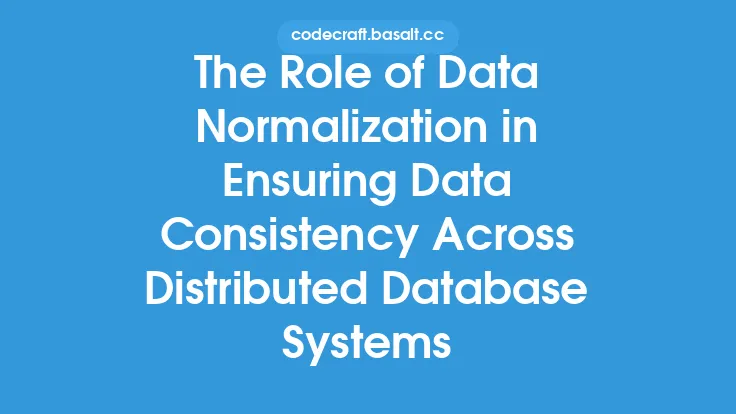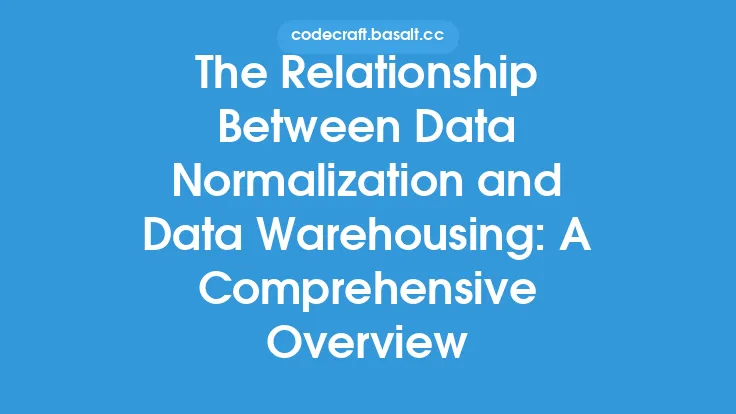Data normalization is a crucial process in database systems that involves organizing data in a way that minimizes data redundancy and dependency. By normalizing data, database administrators can ensure that their data is consistent, scalable, and easily maintainable. In this article, we will delve into the benefits of data normalization, exploring how it improves data consistency and reduces data redundancy.
Introduction to Data Normalization Benefits
Data normalization offers numerous benefits, including improved data integrity, reduced data redundancy, and enhanced scalability. When data is normalized, it is organized into tables that are related to each other through keys, ensuring that each piece of data is stored in one place and one place only. This eliminates data redundancy, which can lead to inconsistencies and errors. Additionally, normalized data is easier to maintain, as changes to the data only need to be made in one place.
Improving Data Consistency
One of the primary benefits of data normalization is improved data consistency. When data is normalized, it is stored in a consistent format, making it easier to compare and analyze. This is particularly important in large databases, where data inconsistencies can lead to errors and inaccuracies. Normalized data also ensures that data relationships are maintained, ensuring that data is consistent across the database. For example, in a database that stores customer information, normalized data would ensure that each customer's address is stored in a consistent format, making it easier to compare and analyze customer data.
Reducing Data Redundancy
Data normalization also reduces data redundancy, which can lead to data inconsistencies and errors. When data is redundant, it is stored in multiple places, making it difficult to maintain and update. Normalized data, on the other hand, is stored in one place, eliminating the need for redundant data. This reduces the risk of data inconsistencies and errors, ensuring that data is accurate and reliable. For example, in a database that stores product information, normalized data would ensure that each product's description is stored in one place, eliminating the need for redundant data.
Enhancing Data Scalability
Data normalization also enhances data scalability, making it easier to add new data to the database. When data is normalized, it is organized into tables that are related to each other through keys, making it easier to add new data without disrupting the existing data structure. This ensures that the database can grow and evolve over time, without becoming cumbersome and difficult to maintain. For example, in a database that stores customer information, normalized data would make it easier to add new customers without disrupting the existing data structure.
Improving Data Flexibility
Data normalization also improves data flexibility, making it easier to modify the database structure as needed. When data is normalized, it is organized into tables that are related to each other through keys, making it easier to modify the database structure without disrupting the existing data. This ensures that the database can adapt to changing business needs, without becoming rigid and inflexible. For example, in a database that stores product information, normalized data would make it easier to add new product categories without disrupting the existing data structure.
Reducing Data Anomalies
Data normalization also reduces data anomalies, which can lead to data inconsistencies and errors. Data anomalies occur when data is inserted, updated, or deleted in a way that disrupts the data relationships. Normalized data, on the other hand, ensures that data relationships are maintained, reducing the risk of data anomalies. For example, in a database that stores customer information, normalized data would ensure that each customer's address is updated consistently, reducing the risk of data anomalies.
Improving Data Security
Data normalization also improves data security, making it easier to control access to sensitive data. When data is normalized, it is organized into tables that are related to each other through keys, making it easier to control access to sensitive data. This ensures that sensitive data is protected from unauthorized access, reducing the risk of data breaches and cyber attacks. For example, in a database that stores financial information, normalized data would make it easier to control access to sensitive financial data, reducing the risk of data breaches and cyber attacks.
Best Practices for Data Normalization
To ensure that data normalization is effective, it is essential to follow best practices. These include:
- Normalizing data to the highest level possible, such as third normal form (3NF) or higher
- Using keys to relate tables to each other
- Avoiding redundant data
- Using indexes to improve data retrieval
- Regularly maintaining and updating the database structure
Conclusion
In conclusion, data normalization is a crucial process in database systems that offers numerous benefits, including improved data consistency, reduced data redundancy, and enhanced scalability. By normalizing data, database administrators can ensure that their data is consistent, scalable, and easily maintainable. Additionally, data normalization reduces data anomalies, improves data flexibility, and enhances data security. By following best practices for data normalization, database administrators can ensure that their data is accurate, reliable, and secure.





